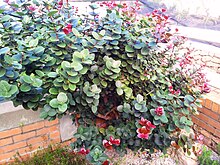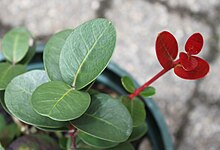| Maurocenia | |
|---|---|

| |
| Young specimen in cultivation | |
| Scientific classification | |
| Kingdom: | Plantae |
| Clade: | Tracheophytes |
| Clade: | Angiosperms |
| Clade: | Eudicots |
| Clade: | Rosids |
| Order: | Celastrales |
| Family: | Celastraceae |
| Genus: | Maurocenia Mill. |
| Species: | M. frangula |
| Binomial name | |
| Maurocenia frangula (L.) Mill. | |
| Synonyms | |
Maurocenia frangula (commonly known as Khoi cherry or vulture-berry) is a small, rounded tree of about 4 metres, that is endemic to the Western Cape, South Africa.
Description


It has small, fragrant, male and female flowers usually on separate trees, cherry-sized edible purple berries and hard yellow wood that is used to make musical instruments.
New growth is bright scarlet. Mature leaves are a very dark green and leathery in texture. The leaves are distinctively round. They grow in opposite pairs up the stem with a noticeable symmetry, each new pair perpendicular to the previous.
Distribution
It naturally occurs only on the Cape Peninsula and in the neighbouring territory of the far south-west corner of the Western Cape. It has been recorded as far north as the vicinity of Saldanha.
Here it is normally found in fynbos, coastal bush or in mountain ravines. Due to the fynbos vegetation being subject to seasonal fires, this species is a resprouter. Nevertheless, it tends to be more common on rocky outcrops and ravines which offer some protection from the fires.
Cultivation
In cultivation it is used as an ornamental tree, or for hedging. It is slow growing, but is extremely long-lived. It flourishes in well-drained sandy soils and a winter-rainfall climate. It tolerates full sun and semi-shade, and is also drought tolerant once established.
As an ornamental, it is valued for its bright scarlet new growth, the shape and symmetry of its mature foliage, its purple edible berries, and its tiny fragrant flowers which attract bees.
References
- "Maurocenia frangularia". Germplasm Resources Information Network. Agricultural Research Service, United States Department of Agriculture. Retrieved 19 October 2010.
- "Threatened Species Programme | SANBI Red List of South African Plants". redlist.sanbi.org. Retrieved 2017-08-04.
- Ecology of Maurocenia in Cape vegetation (pdf)
- "Maurocenia - PlantZAfrica.com article from SANBI". Archived from the original on 2016-01-17. Retrieved 2015-10-13.
| Taxon identifiers | |
|---|---|
| Maurocenia | |
| Maurocenia frangula | |
This Celastraceae article is a stub. You can help Misplaced Pages by expanding it. |